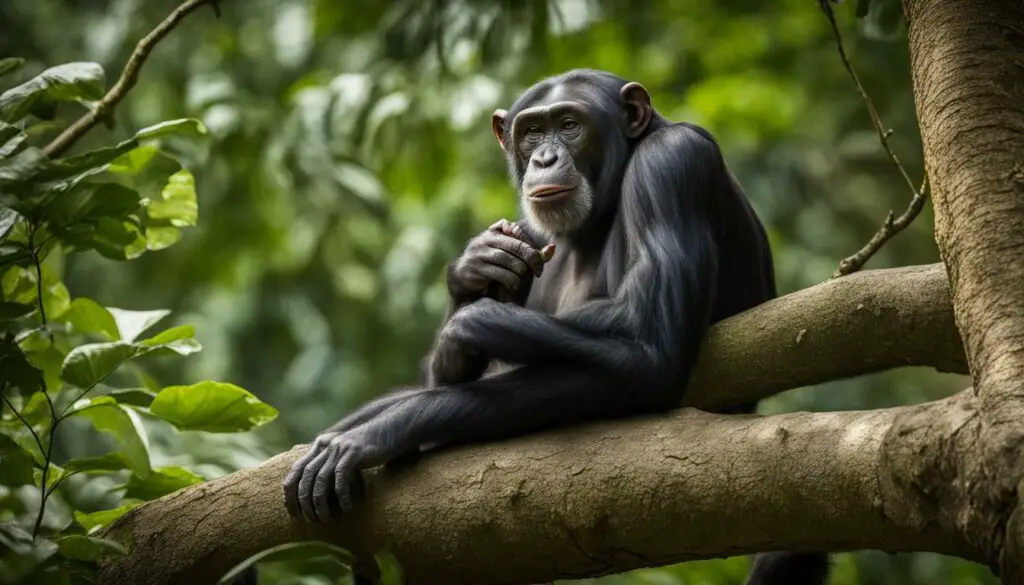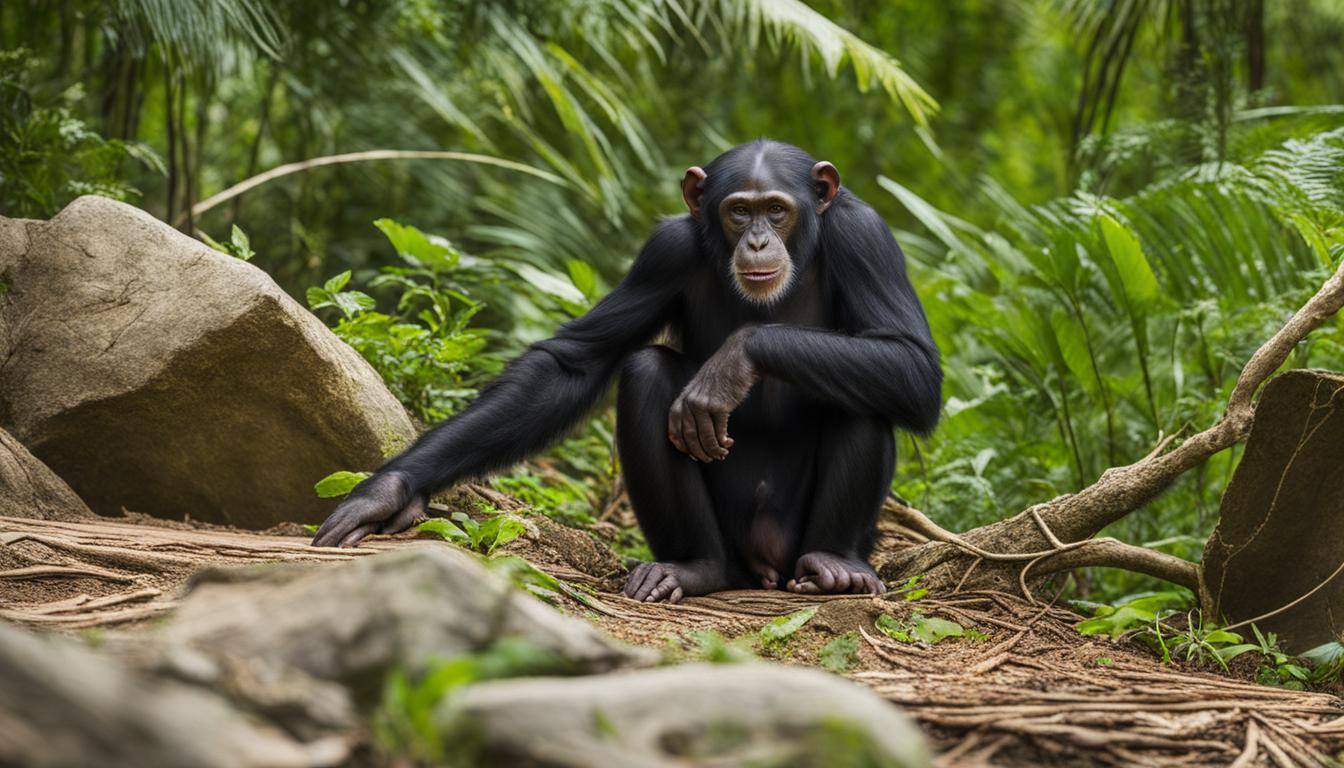Chimpanzees, one of the most fascinating primate species, have undergone incredible adaptations to thrive in their unique habitats. These adaptations not only showcase their remarkable abilities but also shed light on broader primate behavior and adaptations. Let’s explore the incredible world of chimpanzee adaptations, behavior, and habitat.
Chimpanzee adaptations are a testament to their evolutionary success. Over time, they have developed numerous characteristics that enable them to navigate their environments with finesse. From their behavior to their habitat, these adaptations play a crucial role in their survival.
Stay tuned as we delve into the fascinating details of how chimpanzees have adapted to their environments. From their opposable thumbs to their strong canine teeth, each adaptation reveals a unique aspect of their lives. Join us in unraveling the incredible world of primate adaptations, behavior, and habitat.
Opposable Thumbs and Sensory Adaptations
Chimpanzees have unique adaptations that allow them to thrive in their environments. One of the most significant adaptations is their possession of opposable thumbs. The ability to opposable thumbs enables chimpanzees to grip and climb trees with ease. Not only do they use their thumbs for climbing, but they also utilize them for various activities such as grooming and tool use. The opposable thumbs of chimpanzees are a remarkable adaptation that sets them apart from other primates.
In addition to opposable thumbs, chimpanzees have developed sensory adaptations that enhance their awareness of predators and aid in locating food sources. Chimpanzees have keen eyesight, allowing them to spot potential threats and prey from a distance. Their acute hearing enables them to detect the subtle sounds of approaching predators or the movement of potential prey. Furthermore, their well-developed sense of smell helps them locate ripe fruits, nuts, and other food sources in their habitat. These sensory adaptations provide chimpanzees with a heightened sense of awareness, allowing them to navigate their environments effectively.
“Chimpanzees have an incredible ability to adapt to their surroundings through their opposable thumbs and sensory adaptations,” says Dr. Jane Goodall, renowned primatologist. “These adaptations enable them to manipulate objects and navigate their environments with agility and precision. Their thumbs and sensory abilities are essential tools for their survival.”
Opposable Thumbs and Sensory Adaptations Table
| Adaptation | Description |
|---|---|
| Opposable Thumbs | The ability to grip and climb trees; used for various activities like grooming and tool use. |
| Sensory Adaptations | Keen eyesight, acute hearing, and well-developed sense of smell for predator awareness and food location. |
Locomotive Adaptations and Large Brains
Chimpanzees have evolved locomotive adaptations that enable them to navigate their surroundings with remarkable agility. Their long arms and forelimb-suspensory locomotion allow them to effortlessly swing from tree branches, traversing the canopy with ease. However, when on the ground, chimpanzees rely on their shorter hind legs for walking and standing. This unique combination of adaptations allows them to effectively move both arboreally and terrestrially, maximizing their chances of survival in diverse environments.
Another notable adaptation of chimpanzees is their relatively large brains in relation to their body size. This feature sets them apart from many other primates and grants them exceptional cognitive abilities. With larger brains, chimpanzees possess enhanced problem-solving skills and the capacity for complex decision-making. These cognitive abilities are likely crucial for their ability to create and use tools, which further aids in their foraging and survival.
In addition to their locomotive adaptations and large brains, chimpanzees exhibit a high level of social intelligence and cultural complexity. They engage in sophisticated forms of communication, using various gestures, postures, and vocalizations to interact with their peers. This level of social interaction requires a significant degree of cognitive processing and underscores the importance of their large brains in navigating the complexities of their social dynamics.
Overall, the locomotive adaptations and large brains of chimpanzees are vital components of their successful adaptation to their environments. These adaptations empower them to traverse their habitats with agility and navigate complex social interactions. By continually studying and understanding these remarkable traits, we can gain deeper insights into the fascinating world of primates and the evolutionary processes that shape their existence.

Table: Comparison of Locomotion Styles in Primates
| Primate Species | Locomotion Style |
|---|---|
| Gibbons | Brachiation (arm-swinging) |
| Orangutans | Brachiation (arm-swinging) and quadrumanous climbing |
| Gorillas | Knuckle-walking and occasional bipedalism |
| Chimpanzees | Forelimb-suspensory locomotion and occasional bipedalism |
| Humans | Bipedalism |
Communication Skills and Strong Canine Teeth
Chimpanzees possess remarkable communication skills, allowing them to express emotions and convey vital information to other members of their group. Through facial expressions, body language, and vocalizations, chimpanzees can effectively communicate their intentions, establish social hierarchies, and maintain cohesion within their communities. These sophisticated communication abilities are essential for successful cooperation, conflict resolution, and the sharing of valuable resources.
Furthermore, chimpanzees are equipped with strong canine teeth that serve multiple purposes. These sharp, elongated teeth provide chimpanzees with an effective means of self-defense against predators, as well as other competitors for territory and food. Additionally, strong canine teeth enable chimpanzees to tear into the flesh of prey, such as small antelopes and birds, expanding their dietary options and ensuring they obtain the necessary nutrients for survival.
In summary, communication skills and strong canine teeth are two important adaptations that have contributed to the success and survival of chimpanzees. These adaptations enhance their ability to navigate complex social structures, establish dominance, and effectively communicate with their peers. Additionally, strong canine teeth provide chimpanzees with the necessary tools for defense and hunting, expanding their ecological niche and ensuring their continued existence in their respective habitats.
| Adaptation | Function |
|---|---|
| Communication skills | Express emotions, convey information, establish social hierarchies |
| Strong canine teeth | Self-defense against predators, tear into prey, expand dietary options |
Conclusion
Chimpanzees are truly remarkable creatures with a multitude of adaptations that have allowed them to thrive in their unique environments. From their opposable thumbs and sensory enhancements to their locomotive adaptations and large brains, every aspect of their anatomy and behavior showcases their incredible ability to adapt.
These adaptations are not only specific to chimpanzees but also reflect the broader adaptations and behavior observed in primates. Studying chimpanzees’ remarkable skills and characteristics provides us with valuable insights into the fascinating world of primate adaptations and behavior.
By understanding and appreciating the adaptability of chimpanzees, we can gain a deeper understanding of how primates have evolved and continue to navigate their habitats. From their communication skills to their strong canine teeth, each adaptation plays a crucial role in their survival and success.
So, the next time you observe a chimpanzee swinging through trees or using tools, remember the incredible journey they have undertaken to become the amazing creatures they are today. Their adaptations are a testament to the resilience and ingenuity of not only chimpanzees but also the entire primate family.
How do chimpanzees’ adaptations to their environments compare to those of other primates?
Chimpanzee adaptations to environments are remarkable. They use tools for obtaining food, communicate through complex vocalizations, and live in social groups. Compared to other primates, their abilities for problem-solving and cooperation make them one of the most adaptable species in their habitats.
FAQ
How have chimpanzees adapted to their environments?
Chimpanzees have undergone various adaptations to thrive in their unique environments. These adaptations include opposable thumbs for gripping and climbing trees, sensory adaptations for better awareness of predators and food sources, tool use for collecting food and grooming, forelimb-suspensory locomotion for efficient movement, large brains for problem-solving and decision-making, communication skills for social interaction, and strong canine teeth for defense and hunting.
What are the adaptations related to opposable thumbs and sensory perception?
Chimpanzees possess opposable thumbs that enable them to grasp and climb trees. They also use their hands for grooming and tool use. Additionally, chimpanzees have sensory adaptations, including keen eyesight, hearing, and sense of smell, which help them be aware of predators and locate food more efficiently.
How have chimpanzees adapted in terms of locomotion and brain size?
Chimpanzees have adapted to their environments through locomotive adaptations. Their long arms and forelimb-suspensory locomotion allow them to swing from tree branches. Their shorter hind legs are useful for walking and standing on the ground. Additionally, chimpanzees have relatively larger brains compared to their body size, which enables them to make decisions, learn, and create tools.
What are the communication skills and physical adaptations of chimpanzees?
Chimpanzees have developed communication skills to express emotions and convey information to other chimpanzees. These skills include facial expressions, body language, and vocalizations. Moreover, chimpanzees possess strong canine teeth that they use for defense against predators and tearing prey, such as small antelopes and birds.
What can chimpanzee adaptations teach us about primate behavior?
Chimpanzees have demonstrated remarkable adaptations that have allowed them to thrive in their environments. Their opposable thumbs, locomotive adaptations, sensory enhancements, large brains, communication skills, and strong canine teeth have played crucial roles in their survival. These adaptations are not only unique to chimpanzees but also reflect broader primate adaptations and behavior. By understanding and appreciating these adaptations, we can gain a deeper insight into the fascinating world of primates like chimpanzees.











